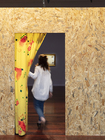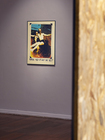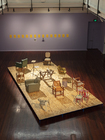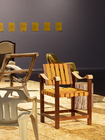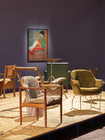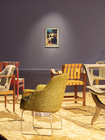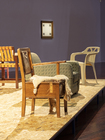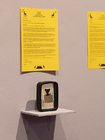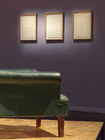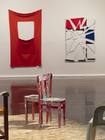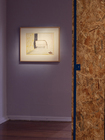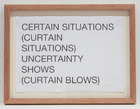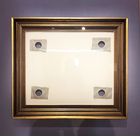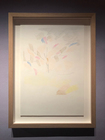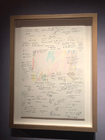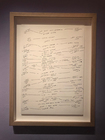If a collection could dream
In December 2018, Agatha Gothe-Snape spent a week at The University of Western Australia’s Lawrence Wilson Art Gallery immersing herself in the Cruthers Collection of Women’s Art. Agatha is in another sense already immersed in this collection, which includes her installation Certain Situations/EXPRESSION CURTAIN, 2013; the large-scale performance document and drawing Every Artist Remembered with Elizabeth Pulie, 2009; and a subscription to her ongoing series of PowerPoint animations begun in 2008 and updated at irregular intervals, currently numbering around 50. The tension Agatha (1) feels between her lived experience as an artist and the disembodiment and discomfort produced by her work being acquired forms part of this exhibition’s emotional core.
I had previously sent Agatha the available resources on the collection, two books (2) and a link to a PDF listing catalogue details for the nearly 700 works that comprise it. Our task was to put the flesh of an exhibition onto the bones of that information. This week became so densely packed with symbols and stories I remember it now as though it was a dream, everything resonant and meaningful. Each object we looked at became a wormhole.
The exhibition Agatha has produced from this intensive period operates too with a kind of dream logic. In part this is because the parameters of its making create so many loops, shifts and compressions of time and space. Originally initiated by former PICA Senior Curator Eugenio Viola, the project was intended to acknowledge, in PICA’s 30th anniversary year, the significant moment in which these two Western Australian art institutions intersected. In 1995, to celebrate the 20th anniversary of International Women’s Day, Joan Kerr and Jo Holder’s National Women’s Art Exhibition saw galleries around Australia present exhibitions showcasing women’s art. For PICA’s contribution then-director Sarah Miller invited Sir James and Lady Shelia Cruthers, who had been collecting art since roughly the inauguration of International Women’s Day, to exhibit their ‘women’s works’ – then numbering around 120 – at the gallery. The critical attention garnered by this exhibition, In The Company Of Women: 100 Years Of Art From The Cruthers Collection, crystallised the family’s vision for a permanent public home for the collection they had been building, which they subsequently focussed entirely on women’s art. Just over a decade later a Deed of Gift was signed with the University of Western Australia, forming the Cruthers Collection of Women’s Art – or CCWA – in its current form.
Agatha is most frequently described as a performance artist, or an artist whose varied material outcomes are informed by the discipline of performance. In the spirit of performance, Agatha’s work does describe art as an experience rather than a discrete object, finding it in embodied encounters between participants, collaborators, audiences or objects. But I think of her true medium, her singular discipline, as something else. It’s generosity. Performance is the right verb, but generosity is what sets the verb in motion and determines its direction.
Each of Agatha’s projects is shaped by a desire to share: the moment, the platform, the resources or opportunities. It explains the frequency with which she collaborates. The visual sparseness of her works reveals something often misunderstood about generosity; that it is not synonymous with abundance. To be generous does not require an excess of means, and sometimes being generous involves withholding or withdrawing. To offer breathing room, the space to think through. An escape.
A recurring motif in her work is the doorway. It has appeared in drawings and paintings as a simple geometric abstraction suggesting a door held ajar or as text: PHYSICAL DOORWAY. This phrase Agatha encountered by chance on a business-card-shaped piece of ephemera found on the street in the midst of her pregnancy, whilst she was contemplating her body becoming its own kind of doorway (3). The open door also appears as a gesture, whereby either literally or by the disarming openness with which Agatha operates, an invitation is extended to cross some literal or metaphoric threshold and to immerse yourself in an idea.
Trying to find comfort in an uncomfortable chair has opened its doors to a multitude of others. Conversations, interviews and chance encounters have been woven into – in Agatha’s perfect phrasing – the ‘meshwork of the exhibition’. A new PowerPoint animation creates a revealing poem from the titles of collection artworks, many of them referring to native and introduced flowers. It is itself titled after a famous Ann Newmarch print from 1975, also part of the collection – We must Risk Unlearning – in which the artist uses her own image to expose how ‘naturalised’ attitudes towards women’s bodies are in fact violent inventions. The exhibition includes a number of artworks loaned from the CCWA chosen by Agatha, many of which formally reference holes, negative spaces or movement through or beyond the artwork. These are placed in dialogue with a frame removed from a 1937 self portrait by modernist Elise Blumann, the subject of many apocryphal stories and speculations, from which mesh-covered holes have been cut in the backing board, presumably to ventilate the work. Letters to a number of artists or their estates with work included in the collection have also requested the loan of a significant chair or a ‘chair like object’ that has played a role in their creative practice. This gesture gives the exhibition its title.
Where the process of exhibiting or of being ‘acquired’ might for an artist produce a complex bouquet of emotions – pride, relief, shame, empowerment, discomfort – the chair provides silent witness and support for creative practice disengaged from the requirement, until now, to perform that labour for a public. These borrowed chairs circumvent expectations of two of the collection’s most recognised thematic areas, self portraiture and the domestic environment. The former implies an ‘essence’ expressed through visibility, and the latter – even when the subject of critique – weds women’s labour to the home. As a functional support, the form of the chair conjures the body through its absence. They become a cypher for the artist, in their place of work. Shifted from being an object in which contemplation, takes place to an object for contemplation, these chairs work like abstraction, providing concrete forms onto which experiential and symbolic readings can be projected whilst also strategically concealing something of their source.
But, the process of explaining what these chairs ‘do’ in the gallery feels like to me like whittling, a process of streamlining their unwieldly power, when what they actually do is the opposite. They open, each of them, onto a lifeworld richer and deeper than I can express. There are so many stories condensed into this exhibition, so many competing or complementary or contradictory experiences, that it wobbles any idea of a clean narrative arc into a dark-matter jelly of sensation.
This density and wobble, to me, is what gives the exhibition its particular dream-like quality. I think of Trying to find comfort in an uncomfortable chair as a dream the Cruther Collection of Women’s Art itself might have, if it were able to. Agatha has produced a contemplative space in which something of the collection’s ‘inner life’ is expressed through symbol, archetype, chance, coincidence and unexpected juxtaposition. The exhibition expresses the combined subjectivities and subconsciousness of each of the artists it represents, of each member of the Cruthers family – Lady Sheila and Sir James, their children John and Sue – of Agatha’s, and of mine. And, like a fresh dream described to a partner over breakfast, it also reveals without our realising our own biases and vulnerabilities. The things that in the light of day we take for granted, or endeavour to keep secret.
Gemma Weston
(then) Curator, Cruthers Collection of Women’s Art
-----
1. The choice to use Agatha’s first name in this essay rather than her surname is intended to acknowledge the spirit of camaraderie that has characterised this process, and to acknowledge that Agatha, myself and PICA Curator Charlotte Hickson are, in the complicated blur of the social and professional that comprises the art industry, friends (I hope) as well as colleagues. I’m aware that the informality of this gesture – particularly applied to a ‘woman artist’ – carries its own politics and could be interpreted as a professional diminishment, but the use of ‘Gothe-Snape’ feels like an authoritative performance I can’t bring myself to do.
2. In the Company of Women exhibition catalogue, Perth Institute of Contemporary Arts, 1995 and Into the Light: The Cruthers Collection of Women’s Art, UWA Publishing Custom, 2012.
3. Recounted to Tai Snaith in the episode ‘Agatha in Puzzling World’ from the podcast series Tai Snaith: A World of One’s Own, 2018/19.
(This text in illustrated pdf form may be found at the + button below.)







